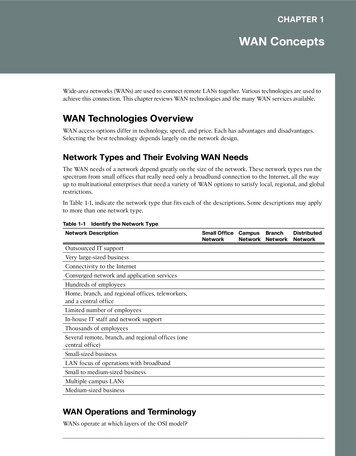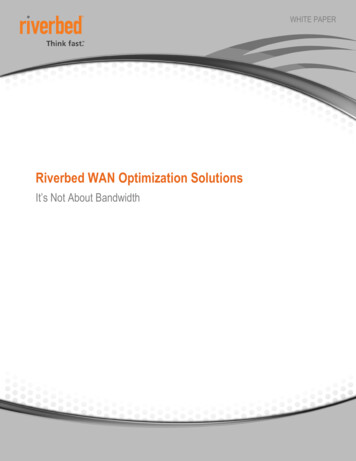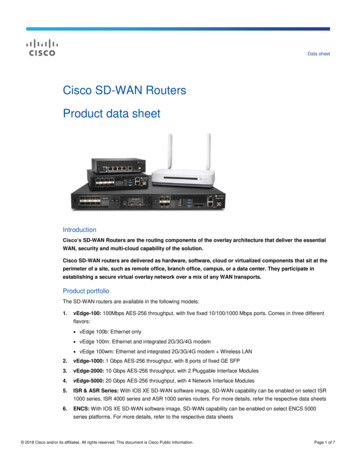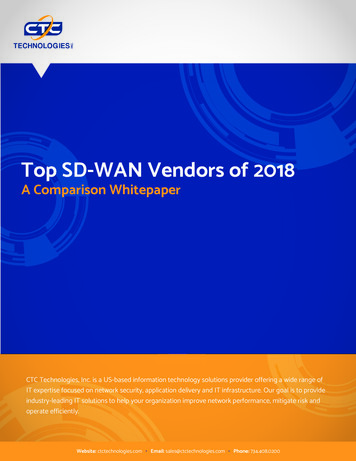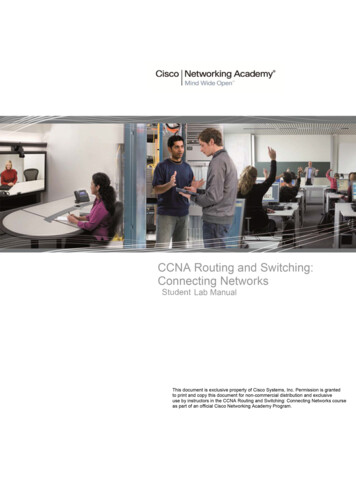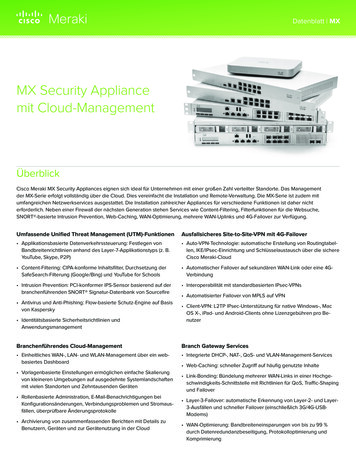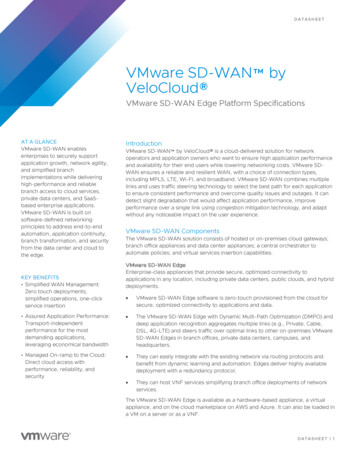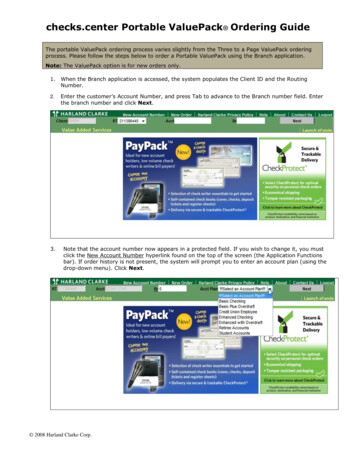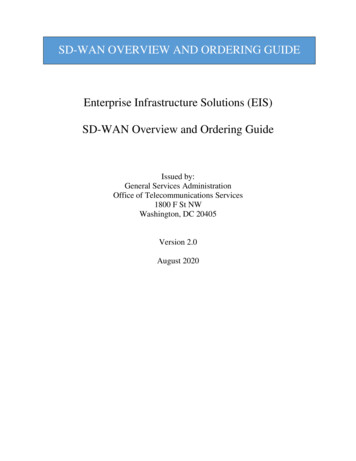
Transcription
SD-WAN OVERVIEW AND ORDERING GUIDEEnterprise Infrastructure Solutions (EIS)SD-WAN Overview and Ordering GuideIssued by:General Services AdministrationOffice of Telecommunications Services1800 F St NWWashington, DC 20405Version 2.0August 2020
Table of Contents1Introduction . 12Overview of SD-WAN Technology . 332.1Defining Characteristics of SD-WAN. 42.2SD-WAN Reference Architecture . 6Why SD-WAN? . 83.1Market Drivers for SD-WAN Adoption. 83.2SD-WAN Benefits and Risks . 93.3Examples of How SD-WAN Could be Used . 114Is SD-WAN Right for You? A Checklist for Initial Evaluation . 135SD-WAN Implementation . 155.1Is DIY or Managed Service the Best Fit for Your Agency? . 155.2The Co-Management Option. 185.3Use Case 1: Managed SD-WAN with Hybrid MPLS and Internet Underlay . 185.4Use Case 2: SD-WAN with Secure Connectivity to Cloud Services . 205.5Use Case 3: SD-WAN to Connect MPLS to Off-Net Sites Using Internet . 216Key Technical Specifications . 227Pricing Basics for SD-WAN . 247.1Managed Service: SDWANS Pricing Components . 247.1.17.28Task Order Unique CLINs . 25EIS Services Used in Conjunction with SDWANS . 257.2.1Access Arrangements. 257.2.2Data Transport . 267.2.3Service Related Equipment . 267.3DIY SD-WAN: Pricing Components . 267.4EIS Services Used in Conjunction with SD-WAN: Pricing . 277.4.1Access Arrangements. 287.4.2Data Transport Services . 287.4.3Equipment and Labor . 29References and Other Sources of Information . 30Pagei
SD-WAN Overview and Ordering GuideFiguresFigure 1: Illustrative SD-WAN Deployment . 4Figure 2: SD-WAN Reference Architecture . 6Figure 3: Hybrid SD-WAN (MPLS plus Internet) . 19Figure 4: SD-WAN Establishing Secure Cloud Connections. 20Figure 5: SD-WAN Connecting MPLS to Off-Net Sites Using Internet. 21Figure 6: How Total Charges for SDWANS are Calculated . 24Figure 7: Pricing for the EIS Managed Offering, SDWANS 24Figure 8: Pricing for DIY SD-WAN .26Figure 9: Pricing Components for DIY SD-WAN 26TablesTable 1:Table 2:Table 3:Table 4:Table 5:Checklist for Agency Consideration of SD-WAN Adoption . 13Comparison of DIY vs. Managed Options for SD-WAN Solutions . 15Checklist for Agency Consideration of DIY vs. Managed SD-WAN . 16SD-WAN Technical Capabilities . 22SDWANS Pricing Components . 24Page ii
SD-WAN OVERVIEW AND ORDERING GUIDE1 IntroductionThis SD-WAN Overview and Ordering Guide (“Guide”) is intended to assist Federal agencytelecommunications customers seeking to implement Software-Defined Wide Area Network(“SD-WAN”) technologies under Enterprise Infrastructure Solutions (“EIS”) contract taskorders. The primary target audience of the Guide is Federal agency customers consideringwhether and how to incorporate SD-WAN into their telecommunications networks. This Guideincorporates information from the industry’s first voluntary SD-WAN standard – SD-WANService Attributes and Services (MEF 70) – published by the MEF Forum in July 2019 (hereafter“MEF 70”). SD-WAN is a virtual WAN network architecture that utilizes various data transporttechnologies and a centralized control function to securely and intelligently connect users toapplications. Unlike traditional WAN, SD-WAN de-couples the transport service1 from itsapplications and software control function,2 resulting in a more agile, reliable and cost-effectivenetwork architecture. Because the software control operates as a separate plane from theunderlying network transport functions, SD-WAN acts as an overlay network to monitor,manage, and optimize the use of that transport. Regarding data transport, SD-WAN permits aFederal agency to combine and integrate multiple data transport technologies – which caninclude Multiprotocol Label Switching (“MPLS”), carrier Ethernet (“CE”), public Internet, fixedand mobile wireless, and satellite-based services. Regarding the applications and controlfunction, SD-WAN relies on pervasive software control working in concert with intelligentnetwork “edge” devices to provide network-wide dynamic traffic routing and prioritizationfunctionality, policy-setting capabilities, and quicker more efficient network deployments andconfigurations.Certain market drivers are pushing enterprises to adopt SD-WAN, including the following:1) High-cost legacy networks (most frequently, MPLS-based) that aren’t keepingpace with dramatically rising bandwidth demands, particularly from video andcloud-based Software as a Service (“SaaS”) and Network-as-a-Service (“Naas”)applications;2) Inflexibility and/or poor quality of service (“QoS”) from legacy networks and theneed to have more centralized network monitoring and management capabilities;3) Expense and inefficiency caused by backhaul of traffic from branch/remotelocations to headquarters or centralized data centers, often to meet cybersecurityrequirements; and4) Overcoming cybersecurity vulnerabilities/challenges that have made thetraditional “perimeter” network defense strategy inadequate.12The WAN transport service is commonly referred to as the “data forwarding plane.”The applications and control function is commonly referred to as the “control plane.”Page 1
SD-WAN Overview and Ordering GuideKey findings and conclusions set forth in this Guide include: SD-WAN is a major advance in wide-area networking, that nearly every Federal agencywill need to consider adopting and most will eventually find to be a compelling option. SD-WAN is ideal for a Federal agency looking to rely more heavily on cloud-basedapplications, while avoiding the expense and quality concerns associated withbackhauling data through a centralized data center. SD-WAN allows for more integrated, in-depth cybersecurity that can meet evolvingFederal security requirements if properly implemented and continually monitored. A Federal Agency may want to evaluate whether a Managed Service option or Do-ItYourself (“DIY”) option best meets its needs, by evaluating the agency’s IT resourcesand the complexity of its networking needs. Some Federal agencies may find that a CoManaged SD-WAN provides the optimum balance, by leaving management of the basicinfrastructure to the service provider but retaining hands-on control of key functions suchas setting network policies, allocating bandwidth, and turning up new branch offices andother remote sites. Currently, SD-WAN is a Managed Service under the EIS Contract.See, EIS Contract Sections B.2.8.10 and C.2.8.10 (SDWANS).Category: Managed Services.Complementary Services Needed: In order to use SDWANS, the agency would need EISTransport services, such as VPNS, ETS, IPS, and Broadband Internet Service (“BIS”) providedby SDWANs.Definitions: Please see the EIS Acroynyms and Abbreviations and the EIS Glossary forclarification of terms and acronyms used in this document. See also, MEF 70, Section 3,Terminology and Abbreviations.Page2
SD-WAN Overview and Ordering Guide2 Overview of SD-WAN TechnologyA Wide Area Network (WAN) is a communications network that spans a large geographicregion and connects networks/users in one location to networks/users in other locations.Traditionally, WANs often have been implemented using a private high-speed network in a huband spoke architecture – with data centers at the hub(s) and the spokes extending to branchoffices and other user locations (which can be tens, hundreds, or thousands of miles from a hub).Notably, traditional WANS will often apply cybersecurity tools at a central hub, thusnecessitating backhaul of all traffic into that hub for verification prior to reaching its finaldestination. Most of the network control in a traditional WAN is decentralized, with routers ateach node independently making decisions about their traffic from a local perspective. TheseWAN networks were originally designed to support relatively predictable and unvaryingtelecommunications requirements, and have worked well (or at least adequately, in most cases)for that purpose. However, traditional WAN networks are becoming increasingly unsuited forkeeping up with today’s highly dynamic demands for bandwidth and connectivity, driven byvideo, mobile data, and other data-intensive and cloud-based applications.3SD-WAN is now seen throughout the industry as a key technology, along with cloud-basedapplications and infrastructure, for enterprises to modernize their networks and keep pace withthe telecommunications demands of their workforce and external clients. However, SD-WAN isstill an evolving and fluid technology, and its standardization is a work-in-progress. The bestavailable industry source for a SD-WAN standard is MEF 70, recently issued in July 2019,4 theindustry’s first version of an SD-WAN service definition standard.5 MEF 70 contains thefollowing diagram of an SD-WAN network architecture.345For example, CTIA reports that wireless mobile data grew by 82% in just one year (2018), and has increased73-fold since 2010. See CTIA 2019 Annual Survey Highlights, ghts .See https://www.mef.net/about-mef MEF describes itself therein as an “industry association of 200 membercompanies, MEF is the driving force enabling agile, assured, and orchestrated communication services thatempower users with the dynamic performance and security required to thrive in the digital economy.”See https://www.mef.net/mef-3-0-sd-wan MEF places MEF 70 within its MEF 3.0 Transformational GlobalServices Framework, “for defining, delivering, and certifying assured communications services orchestratedacross a global ecosystem of automated networks.” See https://www.mef.net/mef30/overviewPage3
SD-WAN Overview and Ordering GuideFigure 1: Illustrative SD-WAN Deployment6In brief, Figure 1 illustrates the separation of the control plane (consisting of the upper elements,Subscriber Web Portal, Service Orchestrator, and SD-WAN Controller) vs. the data forwardingplane, where SD-WAN Edge functions are connecting agency locations to the cloud via twotransport options: (1) a traditional Carrier Ethernet or MPLS network and (2) the public Internet.All of these elements will be described below.2.1Defining Characteristics of SD-WANMEF 70 defines SD-WAN in terms of seven fundamental characteristics:71. A Secure, IP-based Virtual Overlay Network: SD-WAN does not replace, oreven modify, the data transport network(s) upon which it relies, such as anexisting MPLS-based WAN. Instead, it creates and manages an overlay network67This is an illustration of a typical SD-WAN deployment, under a Managed service scenario. (Reproduced withpermission of the MEF Forum.) Source: MEF, MEF SD-WAN Services (MEF 70) presentation (Undated), atpage 5. Available from: https://www.mef.net/resources/White-Papers Additional scenarios and a referencearchitecture are supplied below.See MEF 70, Section 5.2. See also, MEF, Understanding SD-WAN Managed Services: Service Components,MEF LSO Reference Architecture and Use Cases, July 2017 (hereafter, “Understanding SD-WAN”), pp. 5-6.Available from: https://www.mef.net/resources/White-Papers )Page4
SD-WAN Overview and Ordering Guidethat utilizes virtual connections riding on that existing transport. Typically, SDWAN will use IPSec tunnels8 through MPLS or Internet underlay networks.2. Transport-Independence of the Underlay Network(s): SD-WANs can operateover any type of digital transport network, including MPLS; carrier Ethernet; thepublic Internet, as accessed by best-effort broadband services or DedicatedInternet Access (“DIA”);9 wireless such as 4G LTE and 5G (as the latter becomesdeployed more widely); and satellite-based transport.3. Quality-of-Service (QoS) Assurance: QoS is measured in real-time on keyparameters (latency, packet loss, etc.), with the results used to ensure that theperformance level specified by the network manager is being achieved.4. Application-Driven Packet Forwarding: SD-WANs can distinguish data flowsby the application they support. This capability allows users to select whichunderlay transport option a given application will utilize. (This is a specificinstance of the “Policy-based Packet Forwarding” characteristic discussed below.)5. High Availability through Multiple WANs: SD-WANs support packetforwarding over multiple WANs at each site.10 Each WAN underlay network canuse a different wireline or wireless access provider, providing transport diversityand increasing overall availability of connectivity.6. Policy-based Packet Forwarding: SD-WANs can apply customized networkingpolicies to different types of packet flows. This means users can choose theirdesired quality-of-service, security, and/or business policy and their traffic willthen flow over the best-matching transport underlay and overlay.7. Service Automation via Centralized Management, Control andOrchestration: SD-WAN offers centralized management capabilities, typicallyaccessed via a web portal or Application Programming Interface (“API”).Network monitoring and administration can be performed in real-time, withdifferent levels of access and control granted to different roles (e.g., serviceprovider, network administrator, network user). A novel aspect of this centralizedmanagement is that SD-WAN enables “zero touch provisioning” of CustomerPremises Equipment (“CPE”): when new SD-WAN CPE is powered up andconnected, it can retrieve its configuration and policies without needing to send aservice provider installer to the site.8910IPSec is a standard secure network protocol suite that can encrypt and authenticate data packets. A SD-WANservice provider typically builds point-to-point paths called Tunnel Virtual Connections (“TVCs”) across thedata transport network. Each TVC is built using a well-defined set of characteristics. Those characteristics caninclude the following: (i) whether the TVC is public or private, depending on the type of transport on which it isbuilt, (ii) encrypted or unencrypted, etc. See MEF 70, pp. 14-15.DIA provides a dedicated link to an Internet backbone network, rather than one shared among multiplecustomers that may be subject to traffic congestion and slow-downs. DIA typically is more expensive thanbest-effort broadband, but provides a guaranteed level of service quality (bandwidth) backed by a Service LevelAgreement (“SLA”).When a site has two or more WAN connections and each WAN uses a different WAN technology, e.g., Internetand MPLS VPN, it is referred to as a “hybrid WAN.”Page5
SD-WAN Overview and Ordering Guide2.2SD-WAN Reference ArchitectureMEF has presented a reference architecture for SD-WAN. Figure 2 below provides MEF’sillustration of that architecture, followed by a summary of its essential components.Figure 2: SD-WAN Reference Architecture11The reference architecture for SD-WAN includes the following basic components:12 SD-WAN Edge Service Orchestrator SD-WAN Gateway Subscriber Web Portal SD-WAN ControllerThese components are described below.SD-WAN Edge: These devices13 are located at the “edge” or periphery of the SD-WANnetwork, and serve to initiate and terminate the FIPS 140-2/3 compliant encrypted connections1112Source: Understanding SD-WAN, p. 12 (Figure 9). (Reproduced with permission of the MEF Forum). Notethat this figure contains not only the various SD-WAN components, but secondarily also identifies thestandardized interfaces between functions of the MEF’s Lifecycle Service Orchestration (“LSO”) construct(Cantata, Allegro, Legato, etc.). For more details on these interfaces, see MEF 55, Lifecycle ServiceOrchestration (LSO): Reference Architecture and Framework, March 2016.See Understanding SD-WAN, pp. 7-9. Note that the MEF 70 document itself does not supply a referencearchitecture.Page6
SD-WAN Overview and Ordering Guidethat comprise the basic transport links of the virtual overlay network. They perform this functionover the many different types of wired or wireless underlay network that are compatible withSD-WAN. Edge devices also measure QoS performance in real-time, apply the selected QoS,security, and business policies to different data flows, and route them accordingly over the bestmatching network underlay and overlay. In other words, Edges receive data packets from thetransport network and determine how those data packets should be handled and routed accordingto routing information, applicable policies, service attributes,14 etc. Edges are part of the SDWAN service provider’s network, but are commonly located at the customer’s premises when itis a physical network function.SD-WAN Gateway: This is essentially a variant of an SD-WAN Edge that also enablesconnection of SD-WAN sites to other sites interconnected via alternative VPN technologies, e.g.,MPLS or Carrier Ethernet VPNs. While the gateway function permits intercommunicationbetween the two VPNs, it isn’t possible to extend SD-WAN characteristics such as applicationdriven packet forwarding into the VPNs that are beyond the boundaries of the SD-WAN itself.SD-WAN Controller: An SD-WAN network has only one Controller, which is responsible formanaging all of the Edge and Gateway devices on the network. Device management includesconfiguration and activation of devices, IP address management, and establishing the policiesapplied to those devices. he SD-WAN controller maintains connections to all SD-WAN Edgesand SD-WAN Gateways to identify the operational state of SD-WAN paths across differentWANs, and retrieves QoS performance metrics for each SD-WAN path.Service Orchestrator: “The Service Orchestrator provides the service management of the SDWAN service lifecycle including service fulfillment, performance, control, assurance, usage,analytics, security and policy.” The SD-WAN Controller and Service Orchestrator functionsmay be combined in some provider’s implementations of SD-WAN.Subscriber Web Portal or API: This provides the “dashboard” interface for the centralizedmanagement and control of the SD-WAN. A web portal is typically provided for a ManagedService implementation of SD-WAN, whereas an API is typically used for DIY implementation.Both versions serve the same purpose, allowing appropriately-credentialed users to engage innetwork monitoring, management, or service modifications such as establishing different QoS,security or business policies.1314In reality, the “Edge” is a set of functions that can be performed by a physical CPE device, or implemented as asoftware-based virtual network function (“VNF”) running on a virtual CPE. See MEF 70 at Section 6.2.“Service attributes” refers to capturing specific information that is agreed on between the SD-WAN serviceprovider and subscriber and describes some aspect of service behavior, such as service uptime, application offlow objectives, etc.Page7
SD-WAN Overview and Ordering Guide3 Why SD-WAN?This section reviews the marketplace factors that are driving enterprises to adopt SD-WAN, thebenefits and potential risks of the technology, and some examples of how a Federal agency coulduse SD-WAN to improve its delivery of network capabilities.3.1Market Drivers for SD-WAN AdoptionMany private sector enterprises and some forward-thinking public sector agencies15 have beenturning to SD-WAN as a new and highly-effective solution to several widespread networkingproblems. Based on a review of public case studies undertaken on behalf of GSA,16 the mostfrequently-cited driver leading enterprises to deploy SD-WAN is their reliance on a legacynetwork (most frequently, MPLS) that is high-cost and incapable of providing the bandwidthspeeds demanded by today’s bandwidth-intensive applications.A second common driver of SD-WAN adoption is quality of service problems (e.g., networkoutages) with the customer’s legacy telecommunications networks and the need to have morevisibility and control over the network. Numerous case studies attribute lost sales/profits andother business-impacting effects to poor service quality.A third common problem seen as driving SD-WAN adoption is the existence of a de-centralized,disaggregated IT/telecom infrastructure with no centralized management or monitoringcapabilities.A fourth common driver of SD-WAN adoption is delayed/slow market roll-out or limitedlocation placement due to a dependence on carrier provisioning of lines or circuits.A fifth common reason given for SD-WAN adoption is the need for the legacy system tobackhaul traffic from branch/remote locations to headquarters or centralized data centers, leadingto inefficient traffic routing and potential failure points.Other common drivers to SD-WAN as identified by enterprises include overcomingcybersecurity vulnerabilities/challenges and increasing demand for cloud-based applications. Asexplained further below, routing cloud-based services traffic through a common data center, astypically occurs in a traditional WAN, degrades performance and unnecessarily consumes1516One example is California’s Monterey County, which has been deploying SD-WAN to about one-quarter of its120 locations, allowing it to reduce costs while maintaining service quality by substituting Internet transport forMPLS circuits. See State Tech Magazine, “SD-WAN Technology vs. MPLS: Cutting Costs on the Road toDigital Transformation” (6/26/2018), ansformation-perfconQSI, Report on SD-WAN Industry Use and Test Cases (5/21/2019), p. 4 and Attachment 1. Similar SD-WANdeployment drivers are seen in other market studies, see, e.g., Jim Hodges, Heavy Reading Reports, “SD-WANImplementation & Differentiation Layer Strategies” (February 2017), produced for Juniper l/pdf/whitepapers/2000666-en.pdf . See also the MEF Webinar“Standardized MEF 3.0 SD-WAN Services: Aligning the Industry” (05/22/1019). Available 38?utm source MEF&utm medium brighttalk&utm campaign 357538%20Page8
SD-WAN Overview and Ordering Guidebandwidth. SD-WAN can allow for direct routing to/from cloud-based services, therebyincreasing networking efficiency, without compromising cybersecurity.3.2SD-WAN Benefits and RisksSD-WAN is now seen in the industry as a major innovation that can improve WANs’performance and solve the most common problems faced when using a traditional WAN. At thetop of the list of its benefits, SD-WAN can enable an agency to connect multiple sites via asecure, flexible set of WANs and choose the most cost-effective transport options available tomeet each site’s particular requirements. For example, for some sites and applications, agenciescan replace expensive, high-performance MPLS circuits with cheaper, best-effort broadbandInternet or wireless 4G LTE connectivity.17 The cost savings can be substantial, given thatMPLS price levels (e.g., measured per 100 MB of bandwidth) can be an order of magnitudehigher than those Internet and wireless alternatives.18 In addition, SD-WAN can providesignificantly better network performance than traditional WANs when measured along thedimensions of agility, scale-ability, service availability, and resiliency. For example:1718 SD-WAN allows agencies to adopt and enforce network-wide policies withrespect to security, least-cost routing, and SLAs. Attempting to do so in atraditional WAN context is often impractical and expensive, since it wouldrequire site-by-site, hands-on interventions instead of the near-instantaneous, onetime adjustments afforded by the SD-WAN controller and Subscriber WebPortal/API. SD-WAN gives end-to-end, real-time network monitoring capabilities throughdashboard-type access, i.e. visibility through a single pane of glass. Dependingupon the chosen degree of agency control (i.e., DIY vs. Managed Serviceoptions), that visibility can translate into extensive real-time adjustment ofnetwork-wide policies, providing an unprecedented level of agility whencompared to a traditional WAN. In similar fashion, the “zero-touch” capability of SD-WAN allows agencies toundertake fast and simplified set-up/take-down of network “edge” locations. Thiscan be a compelling advantage for agencies that experience rapid turnover ofremote locations needing access to their network. Combined with the routingflexibility enabled by its network-wide policy application, SD-WAN can scale thenetwork’s reach and capacity much more rapidly and completely than a traditionalWAN. By making use of multiple data transport technologies – which can usephysically-distinct facilities for diversity – in a blended, seamless fashion via itsdynamic policy control capabilities, SD-WAN can greatly improve networkresiliency as well as overall network uptime.The industry also anticipates that fifth-generation “5G” wireless services will also play an important role in theunderlying connectivity for SD-WANs as those services are deployed.Given the wide variation in actual network architectures and their served demand, it is not feasible to providemeaningful price comparisons on a generalized basis.Page9
SD-WAN Overview and Ordering GuideAmong the highest-priority goals when deploying SD-WAN will be to ensure that Federalcybersecurity requirements will be met, not only upon initial adoption but on a continuous,ongoing basis. Those requirements are prescribed by the FISMA 2014 law19 and itsimplementation in the NIST guidelines on cybersecurity. With respect to use of cloud services,the FedRAMP website provides detailed information about how a Federal agency can select aCloud Service Provider (“CSP”) who is FedRAMP certified (or who can become certified).20The site also explains FedRAMP recommendations and best practices for Federal agencies’ongoing cybersecurity risk management with respect to CSPs.21 In addition, the longstandingTrusted Internet Connections (“TIC”) initiative, designed to ensure the security of Federalnetworks’ external connections to the Internet, is undergoing important revisions to adapt tocloud-based and SD-WAN technologies and architectures. Until now, TIC has required Federalagency traffic to flow through a limited number of physical TIC access points wherecybersecurity controls can be applied. In September 2019, the Office of Management andBudget (“OMB”) issued a Memorandum rescinding those requirements, replacing them with aprocess by which agencies can determine their preferred security controls from a suite ofpredefined TIC Use Case(s).22 The Memorandum identified new TIC Use Cases compatiblewith the most popular cloud solutions (e.g., IaaS, SaaS, PaaS) and SD-WAN (as well as retainingthe traditional TIC solution as a default). It also established a new collaborative process foriterative development of these and additional TIC Use Cases over time, and requires agencies toupdate their own network boundary policies to conform to the Memorandum within one year.23Federal agencies will need to closely monitor the evolution of the “TIC 3.0” framework andensure that their SD-WAN implementations comply with it.From an implementation perspective, SD-WAN also has an important advantage. As an overlaynetwork, SD-WAN can be adopted gradually over time, site-by-site, rather than requiring a flashcut transition to a new network technology. By ch
traditional "perimeter" network defense strategy inadequate. 1 The WAN transport service is commonly referred to as the "data forwarding plane." 2 The applications and control function is commonly referred to as the "control plane." -WAN OVERVIEW AND ORDERING GUIDE

